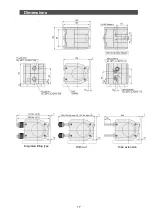
16
Piping and Operation
Caution
Maintain the proper tightening torque for fittings and mounting bolts, etc. Looseness can cause
problems such as fluid and air leaks, while over tightening can cause damage to threads and parts,
etc.
Starting and Stopping Refer to circuit example
1. Connect air piping
Note 1)
to the pilot air supply port <P1>, <P2> and connect piping for the fluid to
be transfered to the suction port <FLUID IN> and the discharge port <FLUID OUT>.
2. Using a regulator, set the pilot air pressure within the range of 0.2 to 0.5 MPa. Then, the pump
operates when power is applied to the solenoid valve
Note 2)
of the pilot air supply port and fluid
flows from the suction port <FLUID IN> to the discharge port <FLUID OUT>. At this time, the
throttle on the discharge side is in an open state. The pump performs suction with its own power
even without priming. (Dry state suction lifting range: up to 0.5m
Note 3)
) To restrict exhaust noise,
attach a silencer to the solenoid valve air exhaust port.
3. To stop the pump, exhaust the air pressure being supplied to the pump with the solenoid valve of
the air supply port.
Note 1) When used for highly permeable fluids, the solenoid valve may malfunction due to the gas
contained in the exhaust. Implement measures to keep the exhaust from going to the
solenoid valve side.
Note 2) For the solenoid valve, use an exhaust center 5 port valve. If air in the drive chamber is not
released when the pump is stopped, the diaphragm will be subjected to pressure and its life
will be shortened.
Note 3) When the pump is dry, operate the solenoid valve at a switching cycle of 2 to 4 Hz. If
operated outside of this range, the suction capacity might reduce.
Discharge Flow Rate Adjustment
1. The flow rate from the discharge port <FLUID OUT> can be adjusted easily by changing the
switching cycle of the solenoid valve on the air supply port.
Circuit example
P1
P2
FLUID
OUT
FLUID
IN
Air
supply
Regulator
5 port
solenoid valve
(Exhaust center)
Transfer fluid
Process
Pump
Air filter
Strainer
Throttle

















